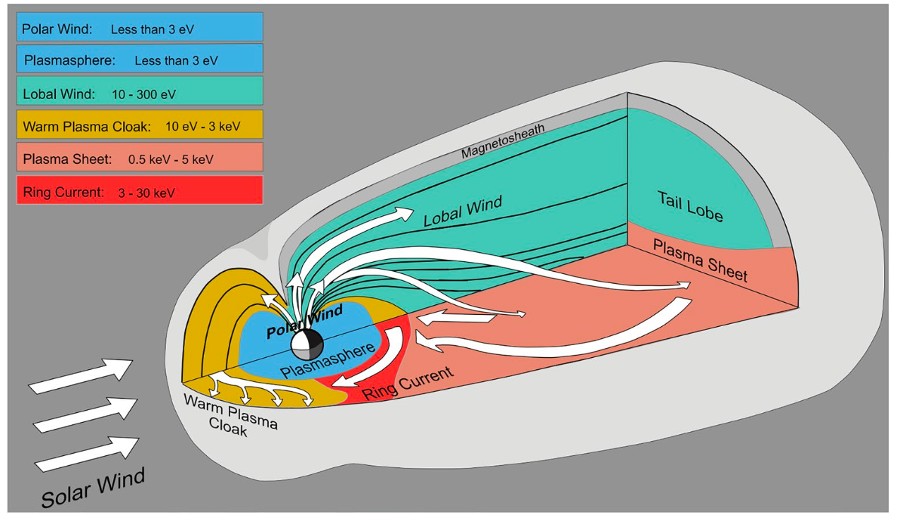OxySpace: The Oxygen Plasma Cloak in the near-Earth space environment: implications for space weather
This research project is centered on studying the effects on the Earth’s magnetosphere of the (cold) plasma that escapes from the ionosphere, and strives to respond the following question: How oxygen ions flowing out from the upper atmosphere and ionosphere affect space weather? The ionosphere is one of the major sources of plasma for the magnetosphere, together with the solar wind, and its relative contribution changes with time and depends on magnetospheric (e.g., storms and substorms) and solar wind conditions. We will investigate the dynamics of ionospheric-originating plasma throughout the magnetosphere as a function of the solar wind and magnetospheric variations. In particular, we will focus on a population that has not been properly characterized to date: the Warm Plasma Cloak (WPC). The WPC can contain substantial amounts of heavy ions (O+), but the prevalence of the O+-rich WPC remains unknown. In addition, the ionospheric plasma has the ability of modifying the properties of the interface between the magnetosphere and the solar wind as it changes the rate at which magnetic reconnection, the primary coupling mechanism between them, operates. We anticipate that the WPC can play a significant role in shaping that coupling, and that space weather models will improve when they account for the WPC effects on the magnetosphere. We will investigate the micro- and meso- scale effects of the cold plasma component on the coupling of the Earth’s magnetosphere with the solar wind. In-situ spacecraft observations in different regions of the magnetosphere will be the key element used to tackle this research project.
In particular, we use the in-situ measurements data from the recent NASA's Magnetospheric Multiscale (MMS) mission to statistically study the prevalence and effects of the WPC, complemented with other mission data such as ACE and Wind to obtain the solar wind context. Ultimately, we will cross-correlate the MMS observations to the pristine solar wind properties at 1 AU and geomagnetic activity of the magnetosphere.

Figure: Plasma regions inside the magnetosphere. Credit: Chappell et al 2008
Objectives
- Describe the prevalence and characteristics of the Warm Plasma Cloak, including O+-rich periods, based on more than 6 years of MMS data.
- Examine the micro- and meso-scale impacts of the O+-rich WPC on Space Weather via solar wind-magnetosphere coupling.
Expected results impact
We expect our findings to be important for improving space weather forecasting tools, which currently do not include the effects of the ionosphere source. Space weather forecasting tools based on MHD modelling can be improved by including a multi-fluid approach that accounts for the dense ionospheric component and its effects. Tools based on empirical models can be directly improved using the findings of this project, which will provide empirical relationships between SW parameters, geomagnetic activity, and the O+ rich WPC. Our findings will provide the foundations for future work to exploit and implement these key findings in space weather forecasting.
In this project, the Earth's magnetospheric system is used as a natural laboratory to study magnetic reconnection. Its outcome has direct implications for both fundamental plasma physics and the more applied space weather field. Moreover, and putting this research effort into a broader context, magnetic reconnection is a ubiquitous process in plasmas, and therefore reconnection involving plasmas of different temperatures is a common process in other planets of the solar system. Finally, magnetic reconnection occurs in fusion reactors as an unwanted phenomenon that prevents the required level of plasma confinement to initiate and maintain the fusion reaction.
Project team
- Dr. S. Toledo-Redondo, project PI (University of Murcia, Spain)
- V. Montagud-camps, PostDoc (University of Murcia, Spain)
- Prof. Mats André (Swedish Institute of Space Physics, Uppsala, Sweden)
- Prof. Stephen A. Fuselier (Southwest Research Institute, Texas)







